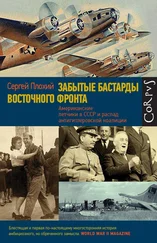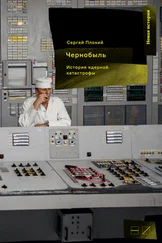Without the expertise and manufacturing base of Slavsky’s Ministry of Medium Machine Building, the construction of the Chernobyl nuclear plant turned out to be a major challenge. The construction and plant managers, along with party officials, tended to report achievements, whereas the KGB, charged with maintaining the security of what was still considered to be secret technology and the safety of its operation, was busy pointing out design and construction flaws. Occasionally the local KGB directorate that oversaw the safety and security of the plant served as Vasyl Kyzyma’s secret weapon—another channel through which he and his staff could alert party and state officials to problems with suppliers and lobby for their own interests. For instance, in August 1976, with the deadline for the launch of Unit 1 nearing, the Kyiv regional KGB office reported to republican headquarters on the failure of suppliers to deliver parts and hardware, as well as on their delivery of substandard or damaged items. KGB headquarters then reported the findings of their subordinates to the party’s Central Committee in Kyiv. 19
But the KGB was not only after the suppliers who failed to meet deadlines or comply with quality standards. It also targeted the shabby work done by Kyzyma’s construction crews and Briukhanov’s willingness to approve construction that was not up to industry standards. In February 1979, KGB reports about problems with the construction of Unit 2 reached KGB headquarters in Moscow, forcing none other than Yurii Andropov, the future general secretary of the party and then head of the KGB, to report to the Central Committee about the poor quality of the work. The report held one of Kyzyma’s deputies responsible for building the foundations of the unit without proper hydro isolation, installing pillars that were up to 10 centimeters (almost 4 inches) off the mark, and raising walls that were 15 centimeters (almost 6 inches) off their intended location. 20
Surprisingly, there were no accidents at the plant that could be directly attributed to construction problems. The most serious accident during this phase took place on September 9, 1982. On that day, planned repairs to reactor No. 1 were completed, and the operators began bringing it back to full capacity. Everything went without a hitch until the reactor reached the power level of approximately 700 megawatts of thermal energy (MWt), more than two-thirds of the projected capacity and a dangerously unstable condition in all RBMK reactors. One of the fuel channels burst, releasing enriched uranium into the core of the reactor, and it took operators close to thirty minutes to figure out that something was wrong and shut down the reactor. According to KGB reports, the release caused the beta radiation (high-energy electrons) in contaminated areas to rise to ten times normal levels. 21
The commission investigating the accident concluded that the repairmen were at fault—one of them had allegedly shut the valve of the water coolant channel going to that part of the reactor, causing the fuel channel to burst. Briukhanov’s second-in-command, the chief engineer of the plant, lost his job, but Briukhanov survived. After all, by industry standards, the Chernobyl plant was doing rather well, with a lower accident level than other plants of the same type. In the following year, Briukhanov was awarded the prestigious Order of the October Revolution. 22
But problems persisted. In February 1986, as Briukhanov attended the party congress, and party leaders called for doubling the construction of nuclear units in the next five-year period, the KGB reported on continuing difficulties at the plant, pointing to a breach of technical specifications in the construction of Unit 5. Because the vendors did not deliver the right kind of crushed stone for making concrete, the managers used the stone they had, with particles twice the size of the type that should have been used. The concrete that they poured into the forms therefore failed to get into tight spots, leaving holes in the structure. “The estimated coverage area unfit for use is 300 meters,” wrote the KGB officer. “As Unit 5 comes into use, the technical deficiencies discovered in the production of concrete may lead to accident-threatening situations, including the possibility of human losses.” There was no response to this warning. 23
In March 1986, the all-Union conference of vendors—suppliers of construction materials and specialized hardware—went on for three days and was declared a success in Prypiat. Vasyl Kyzyma, the head of Prypiat’s construction directorate, was among the key speakers. Representatives of twenty-eight firms that provided supplies for the construction of Unit 5 were in attendance, and only two enterprises failed to attend. 24
Viktor Briukhanov was not at the meeting, but the nuclear plant was represented by his chief engineer, Nikolai Fomin. Cooperation with the construction directorate and the launching of new reactors were among his responsibilities. Fomin had become an international celebrity of sorts the previous month, when an article about the Chernobyl power station in the February issue of the English-language magazine Soviet Life quoted him as saying that the station’s cooling pond was being used for breeding fish—an indication of the station’s complete safety. Even if an accident happened, argued Fomin, the automatic security system would immediately shut down the reactor. 25
Fomin never mentioned the 1982 accident at the power plant. It would have been illegal for him to do so. In the summer of 1985, censorship of information about nuclear accidents had been reinforced by an instruction from the new energy minister of the USSR, Anatolii Maiorets. “Reports on adverse consequences of ecological effects on service personnel and the population, as well as of energy sources (the effect of electromagnetic fields, irradiation, or pollution of the atmosphere, bodies of water, or soil) on the environment, are not subject to open publication in the press or in radio and television broadcasts,” read the minister’s instructions to the industry’s personnel. 26
At the conference, the usually active and energetic Fomin was largely silent, not because of the ministry’s restrictions on speech but because of injuries he had sustained in a car accident in late 1985. He had just returned from medical leave, and his very appearance at the conference was something of a miracle: those in attendance could see how difficult it was for him to participate in discussions—indeed, how hard it was for him to speak at all. Grigorii Medvedev, who was no longer deputy chief engineer of the plant, but had moved to Moscow to serve in the all-Union Ministry of Energy and Electrification, attended the conference to represent the ministry. He found Fomin a shadow of his former self. Medvedev almost did not recognize his colleague, whom he had known as a healthy man with a charming smile and a pleasant voice, someone always “coiled like a spring and ready to leap.” “There was some kind of restraint in his whole appearance, the mark of the suffering he had borne,” Medvedev later recalled. He said to Fomin, “Maybe you have to take a few more months and get better. Those were pretty serious injuries.” But Fomin would not listen: “Got to get on with the job,” he said.
Viktor Briukhanov gave Fomin all the support he could offer. “I do not think it’s particularly serious,” he said of Fomin’s physical condition. “He’s made good recovery,” he assured Medvedev. “He’ll get back to normal faster by working.” The party secretary of the power plant had convinced Fomin to come to work earlier than scheduled because Briukhanov was attending the party congress in Moscow, and it was up to Fomin, as second-in-command, to take charge of the plant. To Medvedev, Briukhanov himself looked overworked and tired. The director was particularly concerned about units of the power plant leaking radioactivity. Altogether the leaks amounted to about 50 cubic meters (1,765 cubic feet) of radioactive water per hour coming from the drainage channels and air vents. The steam extraction units were barely able to deactivate the radioactive water. They were holding so far, but had reached the limit of their capacity. The only effective way to deal with the problem was to stop the reactors and carry out the repairs, but that would jeopardize the fulfillment of the annual plan of electricity production, and Briukhanov was not ready to face the rage of the party officials, whose main concerns were deadlines and quotas. Briukhanov told Medvedev that he was considering a move somewhere else—thoughts of a possible job abroad that he had previously dismissed were now probably testing his resolve to stay in Prypiat. 27
Читать дальше
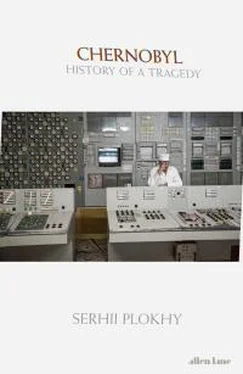

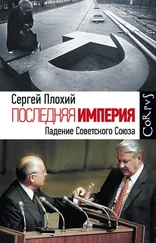



![Сергей Плохий - Чернобыль - История ядерной катастрофы [litres]](/books/385171/sergej-plohij-chernobyl-istoriya-yadernoj-katastrof-thumb.webp)
![Сергей Плохий - Человек, стрелявший ядом [История одного шпиона времен холодной войны]](/books/405163/sergej-plohij-chelovek-strelyavshij-yadom-istoriya-od-thumb.webp)

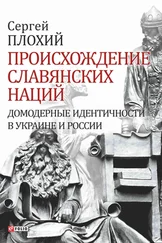
![Сергей Плохий - Потерянное царство. Поход за имперским идеалом и сотворение русской нации [c 1470 года до наших дней]](/books/433093/sergej-plohij-poteryannoe-carstvo-pohod-za-impersk-thumb.webp)
